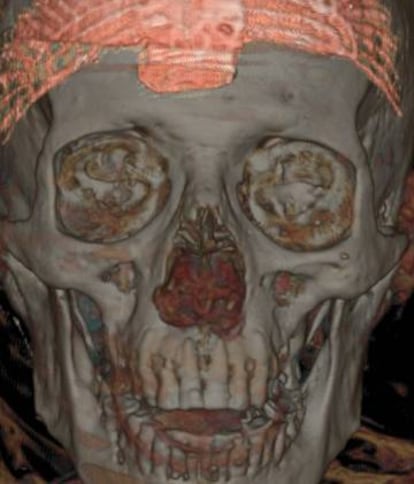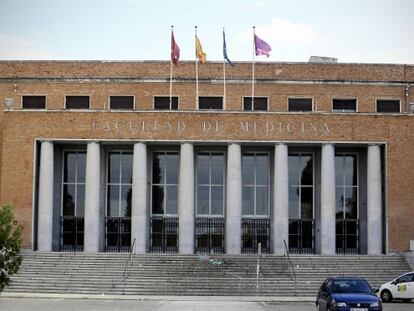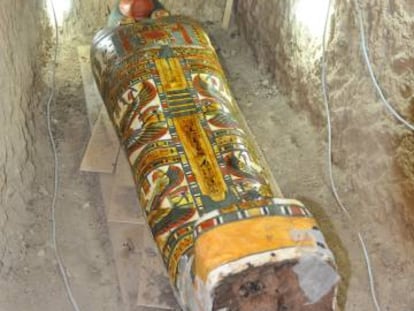A Madrid mummy is found to be a pharaoh’s eye doctor
A scan reveals that Ptolemy II’s ophthalmologist lies in Madrid’s National Archeology Museum


In the middle of the night on June 6, 2016, an enormous refrigerated trailer with a two-vehicle escort parked in front of the Emergency Unit at Quirónsalud University Hospital in Pozuelo, outside Madrid. An extensive team of doctors was waiting there to examine the four bodies traveling within – three Egyptians and a male from the Canary Islands.
The specialists had just 15 hours to carry out a project dubbed CT Mummy Operation: visitors to the National Archeology Museum were not meant to notice that the four bodies had spent the night elsewhere, while hospital patients were not to suspect that they were sharing state-of-the-art medical resources with humans who had lived more than 2,000 years ago.
There is nothing casual about the iconography and it is clear that he wanted to register his beliefs and the responsibilities that had elevated him to the upper echelons of society
National Archeology Museum report
Now, two years later, the museum has released the results of that examination. And it turns out that one of the mummies, which was covered in jewels and charms beneath its bandages, was the priest Nespamedu, the personal eye doctor of Pharaoh Ptolemy II, and perhaps also Ptolemy III (the jury is still out on this latter claim).
His Spanish odyssey began in 1925, when the steamship C. López y López docked in the port of Barcelona with an unusual cargo: a mummy that had been bought in Cairo by the scholar Ignacio Bauer with scarcely any documentation, according to a report by Esther Pons Mellado, a specialist at the National Archeology Museum. In fact, at first it was thought to be the body of a woman.

Thanks to the tomography analysis, it has now been established that Nespamedu was a priest who lived between 300 BC and 200 BC and who worked at the Imhotep- Asclepius clinic in Serapeum of Saqqara (Memphis) or else in Alexandria as well as being doctor to the king, according to another report by archeologists María del Carmen Pérez Die and Dr Javier Carrascoso.
The information gleaned from the scan reveals that Nespamedu was a high-ranking official with enough money to have his body prepared for the journey to the afterlife. But according to experts, it is the charms and plaques stored within his bandages that are the most revealing. Two groups of eight plaques have shown up on different parts of the mummy in which the four sons of the deity Horus are represented. Another two plaques feature the goddesses Isis and Nephthys, while representations of the mummification of the corpse together with the god Anubis were found at the top of Nespamedu’s legs.
There are also two plaques featuring the god Thoth and the Eye of Horus, symbolizing magic, protection and purification together with a solar symbol that stands for cosmic stability. Thoth is the god of ophthalmologists, as it was he who put Horus’ eye back after he lost it in his battle with Set.
A Guanche who lived between the 12th and 13th centuries
After its scan at QuirónSalud University Hospital, the Guanche mummy from the Canary Islands underwent a further carbon-14 dating test in 2018.
The mummy had been found in the 18th century inside a cave in the Herques gorge on the island of Tenerife, according to a report by Benigno Sánchez Cabrero from the Energy, Environment and Technology Research Center and Teresa Gómez Espinosa from the National Archeological Museum.
Two samples were sent to the National Accelerator Center (CAN) to be dated using Accelerator Mass Spectrometry (AMS) equipment. This test established that the corpse belonged to a male Guanche – the native island inhabitants – who lived between 1154 and 1260. The Castilians from the peninsula would not conquer the Canary Islands until 1402, first taking Lanzarote before conquering Tenerife in 1496.
This has led specialists to conclude that Nespamedu chose this god on account of his own profession. “There is nothing casual about the iconography and it is clear that he wanted to register his beliefs and the responsibilities that had elevated him to the upper echelons of society,” states a report published in the last National Archeology Museum’s bulletin. “The fact that he was the pharaoh’s doctor makes us think that part of his life was lived in Alexandria, where Ptolemy had his court.”
A third report written by Andrés Carretero Pérez, director of the National Archeology Museum, points out that “mummies are cultural assets that are very vulnerable to changes in the environment and it should be a priority to avoid manipulation and movement as far as possible because there is no such thing as zero risk.”
The mummies are closely monitored, conserved behind glass with air-renewal systems and tightly controlled temperature, humidity and light levels. Such is the fragility of the mummies that the expert Teresa Gómez Espinosa notes how a highly specialized transportation company was chosen to transfer the bodies to the hospital for the scans. Two alternative routes were planned in case of unforeseen circumstances, and the trip took place on a night when the air was dry and the temperature mild. If there had been rain or an increase in humidity levels, the operation would have been called off immediately.
After arriving at the hospital, Nespamedu and the other mummies were carefully introduced into the CT scanner. Nespamedu had 2,739 images taken of his body, which was virtually undressed, allowing the charms and plaques to show up. The headband he was wearing was a winged Scarab charm with a solar disc that also featured the god Khepri, symbol of resurrection and rebirth.
Nespamedu had 2,739 images taken of his body, which was virtually undressed, allowing the charms and plaques to show up
Nespamedu also wore a Usekh collar, particular to the Egyptian elite – one of the most typical pieces of Egyptian jewelry, which normally features a falcon’s head and is supported by the shoulders with a counterweight on the back.
It is known that priests and doctors were trained in the temple where Nespamedu attended to patients. In fact, a chapel dedicated to health was built In Imhotep’s honor and people came there from the most remote regions of Egypt in search of miracle cures. Its god was Thoth, deity of science and medicine, the forefather of ophthalmologists.
English version by Heather Galloway.
Tu suscripción se está usando en otro dispositivo
¿Quieres añadir otro usuario a tu suscripción?
Si continúas leyendo en este dispositivo, no se podrá leer en el otro.
FlechaTu suscripción se está usando en otro dispositivo y solo puedes acceder a EL PAÍS desde un dispositivo a la vez.
Si quieres compartir tu cuenta, cambia tu suscripción a la modalidad Premium, así podrás añadir otro usuario. Cada uno accederá con su propia cuenta de email, lo que os permitirá personalizar vuestra experiencia en EL PAÍS.
¿Tienes una suscripción de empresa? Accede aquí para contratar más cuentas.
En el caso de no saber quién está usando tu cuenta, te recomendamos cambiar tu contraseña aquí.
Si decides continuar compartiendo tu cuenta, este mensaje se mostrará en tu dispositivo y en el de la otra persona que está usando tu cuenta de forma indefinida, afectando a tu experiencia de lectura. Puedes consultar aquí los términos y condiciones de la suscripción digital.
More information
Archived In
Últimas noticias
The brief rise and retreat of Generation Z in Mexico
A floating school teaches children how to save Lake Atitlán
Pablo Escobar’s hippos: A serious environmental problem, 40 years on
From Andorra to Gibraltar, a black market for Ozempic exploits its success: ‘They’re the most sought-after products in the world’
Most viewed
- Why we lost the habit of sleeping in two segments and how that changed our sense of time
- Charles Dubouloz, mountaineering star, retires at 36 with a farewell tour inspired by Walter Bonatti
- Venezuela faces its most tense Christmas yet
- Trump’s obsession with putting his name on everything is unprecedented in the United States
- CBS in crisis after pulling a report on Trump’s deportations to El Salvador (which later leaked online)










































